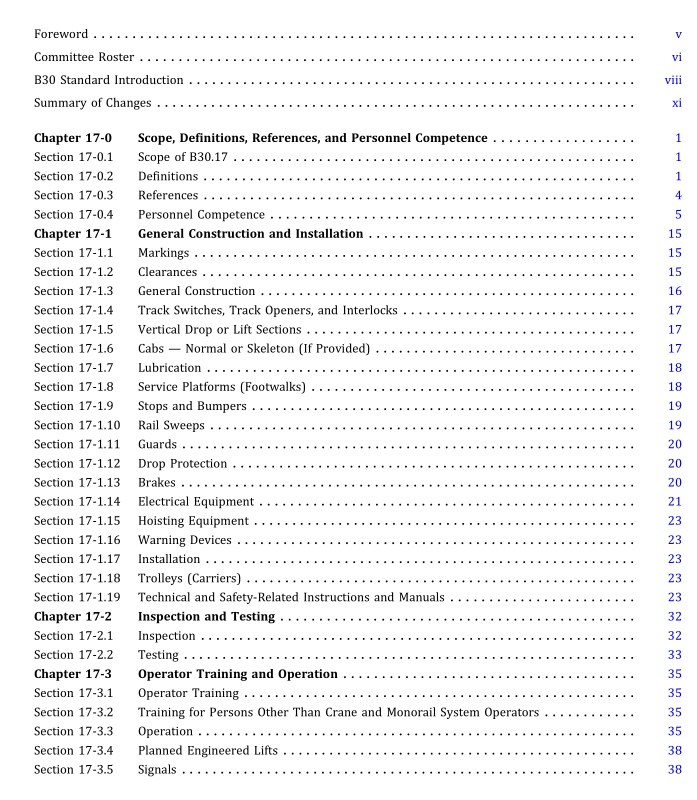ASME B30.17 pdf download

ASME B30.17 pdf download Cranes and Monorails (With Underhung Trolley or Bridge) Safety Standard for Cableways, Cranes, Derricks, Hoists, Hooks, Jacks, and Slings
controller: a device by means of which the operatorcontrols the speed, acceleration, torque, and /or directionof motor-driven equipment.
controller, manual: a controller having all of its basic func-tions performed by devices that are operated by hand.controller, spring-return: a controller that, when released,will return automatically to a neutral (OFF) position.crane: a machine for lifting and lowering a load andmoving it horizontally with the hoisting mechanismbeing an integral part of the machine.
crane, automatic: a crane that, when activated, operatesthrough a preset cycle or cycles.
crane, cab-operated: a crane controlled by an operator in acab attached to the crane or trolley (see Figure 17-0.2-2].crane, cantilever gantry: a gantry or semigantry crane inwhich the bridge girder(s) or truss(es) extend transver-sely beyond the crane runway on one or both sides (seeFigure 17-0.2-3).
crane, double-girder: a crane having two bridge girdersmounted between, and supported from, the end trucks.crane, floor-operated: a crane that is controlled by a meanssuspended from the crane or trolley, or from a wall-mounted station and operated by an operator on thefloor or on an independent platform (see Figure 17-0.2-4).crane,gantry: a crane similar to an overhead crane, exceptthat the bridge for carrying the trolley(s) is rigidlysupported on two or more legs running on fixed railsor other runway (see Figure 17-0.2-5).
crane, hot molten material-handling: an overhead craneused for transporting or pouring molten material.
crane, interlocking: a crane with an interlock mechanismon one or both ends, enabling it to be mechanically lockedto another crane, fixed transfer section, or spur track forthe purpose of transferring a trolley from one to another.crane, jib: a fixed crane, usually mounted on a wall orbuilding column, consisting of a rotating horizontalboom (either cantilevered or supported by tie rods)carrying a trolley or hoist (see Figure 17-0.2-6).
crane,manually operated: a crane whose travelmechanism is driven by pulling an endless chain, or bymanually moving the load.
crane, outdoor: an overhead or gantry crane that operatesoutdoors and for which provisions are not available forstorage in an area that provides protection to the cranefrom weather conditions.
NOTE: An indoor crane that may operate outdoors on a periodicbasis is not classified as an outdoor crane.
crane, overhead: a crane with a movable bridge carrying amovable or fixed hoisting mechanism and traveling on anoverhead, fixed runway structure (see Figures 17-0.2-2,
17-0.2-4,and 17-0.2-9 for the types covered by thisVolume).
crane, pedestal (pillar-jib): a fixed crane consisting of arotating vertical member with a horizontal arm carryinga trolley and hoist.
crane, polar: an overhead or gantry crane that travels on acircular runway.
crane, portable gantry (A-frame): a crane similar to anoverhead crane, except that the bridge for carrying thetrolley(s) is rigidly supported on two or more legssupported by casters (see Figure 17-0.2-7)].
crane, power-operated: a crane whose mechanism isdriven by electric, pneumatic, hydraulic, or internalcombustion means.
crane, pulpit-operated: a crane operated from a fixedoperator station not attached to the crane.
crane,remote-operated: a crane controlled by an operatornot in a pulpit nor in the cab attached to the crane, andcontrolled by any method other than a means suspendedfrom the crane.
crane, semigantry: a crane with one end of the bridgerigidly supported on one or more legs that run on afixed rail, and the other end of the bridge supportedby an end truck suspended from an elevated track (seeFigure 17-0.2-8].
crane, single-girder: a crane having one bridge girdermounted between, and supported from, the end trucks.crane, underhung: a crane with a single- or multiple-girdermovable bridge carrying a movable or fixed hoistingmechanism and traveling on the lower flanges of an over-head runway (see Figures 17-0.2-4 and 17-0.2-9).
crane, wal: a crane with a jib and hoist, with or without atrolley, traveling on a runway attached to the sidewall orbuilding columns.
crane operator, dedicated: an employee whose job isconfined solely to the operation of an overhead organtry crane.
crane operator, nondedicated: an employee who uses anoverhead or gantry crane as a tool to assist in the perfor-mance of his/her regular job.
drift point: a point on a travel motion master switch or onamanual controller that maintains the brake released whilethe motor is not energized. This allows for coasting.drop section: (also known as lift section) a mechanism thatwill permit a section of track(s) to be lifted or lowered outof alignment with the stationary track(s) (seeFigure 17-0.2-10).
electric baffle: conductors that are wired to cut off electricpower to approaching motor-driven equipment if trackswitches, drop sections, and other movable trackdevices are not properly set for passage of equipment.









